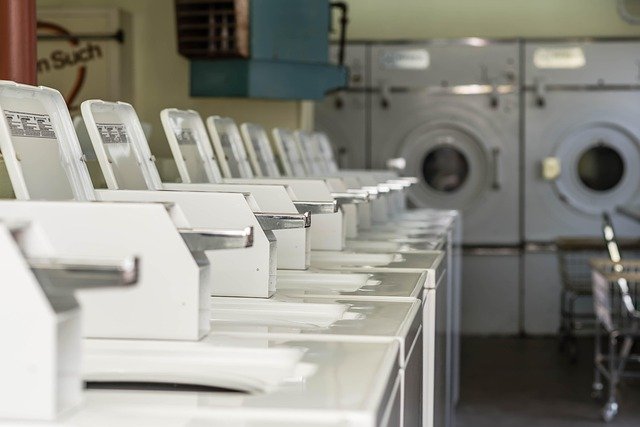I've been helping with laundry chores ever since I was small. In our first house that I remember from childhood, our "laundry room" was a dark corner of the basement where my mother had a washing machine, a dryer, probably a large utility sink (I don't remember for sure), and some ramshackle counter space and shelves. In hindsight, I suspect it was there because it was immediately beneath the kitchen with easy access to plumbing and an exterior wall for the dryer vent. The water heater and water softener were down in that area, too. My memory is a bit hazy because my help then was minimal. Mainly, I was probably helping match socks and fold things I could manage, like hand towels and washcloths. I also remember summers with clothes hung on the line in the back yard.

Image by suericks from Pixabay.
It wasn't until the next house when I was actively doing more of the work through the whole process. This was in a hallway upstairs in what has obviously been an addition. The water heater and water softener were in the basement again there, but someone ran pipes to the new part of the house for the sink and washer. This utility space was essentially a deep closet, and it could be hidden away behind a door so it wouldn't be on full display. We still used a clothesline outside. I will note, however, that this was a very seasonal option. Every year, there were about 13 months of winter where a dryer was essential.
After my family moved to the Pacific Northwest, the new house had a basement laundry room again, but this was a bit more of a finished space than some stuff tucked in the corner. However, the room was long, narrow, and awkward. There were some shelves, and we installed more over the years, but it was always a bit more of a "make do with what you have" than an ideal workspace. Again, we had a clothesline, although this was strung between trees instead of using T-shaped metal posts with parallel lines.
When I got my first apartment, it had no laundry space. I relied on a public laundromat a few blocks away. I have also used laundromat occasionally when traveling. I have avoided owning anything requiring dry-cleaning, and I haven't personally used a laundry service.

Image by Rebecca Varney from Pixabay.
My second apartment, however, had hookups for laundry in a room next to the kitchen, and it adjoined a "half-bath" with a toilet and sink, all underneath the upstairs bathroom. It was largely dictated by plumbing, but the use of space was clearly intentional as well. I had to supply my own appliances. I bought them used, and sold them again when I moved out. No line-drying there. I used a clothes dryer exclusively. No one needed to see my tighty-whities!
I think these experiences cover most common laundry spaces: none, a dedicated space, or an afterthought. However, there is also a popular option I drew in blueprints during my short career as a draftsman: the mud room. Many suburban homes are designed so the garage accesses the kitchen through a utility room where boots, jackets, etc. can be stored. This space is also often designed with room for laundry, which makes sense because it is near the kitchen for plumbing access, and families often have kids who need to shed dirty clothes before tracking mud through the house, so why not have the laundry right there, too?
But that leads into another point: The USA and Canada, especially here in the west, are quite newly settled. Most homes are designed with modern plumbing and electricity from the start. Modern appliances are an assumption baked into the blueprints. Historically, laundry was another matter entirely. I remember the Little House books by Laura Ingalls Wilder listing the chores by day:
Wash on Monday
Iron on Tuesday
Mend on Wednesday
Churn on Thursday
Clean on Friday
Bake on Saturday
Rest on Sunday
Yes, I had to look up the list. I remember it existed, but not the details. It was a major chore, too. Bernadette Banner demonstrated the process according to Edwardian home economics manuals in the video below:
Obviously, homes built in that era were not designed for modern laundry. Most weren't even designed for electricity, gas, or indoor plumbing! These homes may have a washing machine in the kitchen now because that was where utilities were all installed, and if I am not mistaken, that tradition extends to new construction. It makes a degree of sense, too. After all, water for washing the old-fashioned way would have been boiled on the stovetop there already. There are countertops for folding and sorting in place. One can switch from cooking to laundry as timing allows thanks to modern conveniences.
Is your washer in the kitchen, or do you have a dedicated laundry room? What is the norm in your country? Do you have an odd setup or some clever ideas to suggest for anyone remodeling/building a laundry room? Let me know in the comments, and share a snapshot if you dare! I won't judge. I won't share pics of my own, though. No one needs to see that.

Well, I put the dirty clothes in water and click the buttom :P
The house where I grew up in the 1960s was a single level house, not new. A narrow room off the kitchen housed the back entry, a sink, and the washer and dryer. It also contained a built-in ironing board that saw plenty of use. That room didn't appear to have been added on, so it must have always been intended for that purpose. When the weather cooperated, the laundry was hung out on the line to dry. I'm not sure if this was done to save on the electrical bill, or because my mother liked the scent of line-dried clothes, or simply tradition. I remember a neighbor just down the hill used a wringer washer, which I found fascinating.
Hmmm... Washing Machine in the Kitchen. Just outside the kitchen is a walled off room open to air with clotheslines. Pretty simple I guess. A lot of people use a clothes-horse if they do not have the space.
Here in Europe and I guess specifically in Latvia most have washers or washer+dryer in 1 combo in almost every home or even individual apartment. My washer/dryer is in bathroom but I have seen people having them also in the kitchen. Depends how spacious said living spaces are. Newer homes or bigger homes have dedicated laundry rooms.
Recently in one of the bigger shops here they opened a laundromat and whenever I go to the shop I hardly see it used. Maybe students use them if their dorms don't have washers/dryers or people who have run into trouble with their machines use them. Maybe it is hardly used due to the unreasonably high prices. I think it was around 7 euros per 9 kilo wash.
I found American washers and dryers are so different from what we have here. Like, dryers for one work on completely different principles than what I encountered in States.
Can you be more specific about dryers? Ours use electricity or gas to heat air, and tumble the clothing in a drum while venting the air outside. There are newer (but expensive) machines which work more like a dehumidifier and collect the water differently.
The ones I saw in America were the ones that heat air.
Ours works like dehumidifier I would say. :)
There are also sophisticated systems which work like a heat pump, but those are exceptionally expensive, at least here.
Lol, your childhood laundry memories remind me of my grandma’s basement, same dark corner, same socks to fold. Line drying clothes in summer was the best part, feel the sun too
When I was small we had the old wringer washer, it was in a room with no walls, it only had a roof, it was on the outside of my dad's bar. We did not have a dryer and hung them on a rope between the trees as you had, we had a 2x4 in the middle with a V cut in it. It was to keep the clothes from dragging on the ground.
Now, I have a room with a washer and dryer in it.